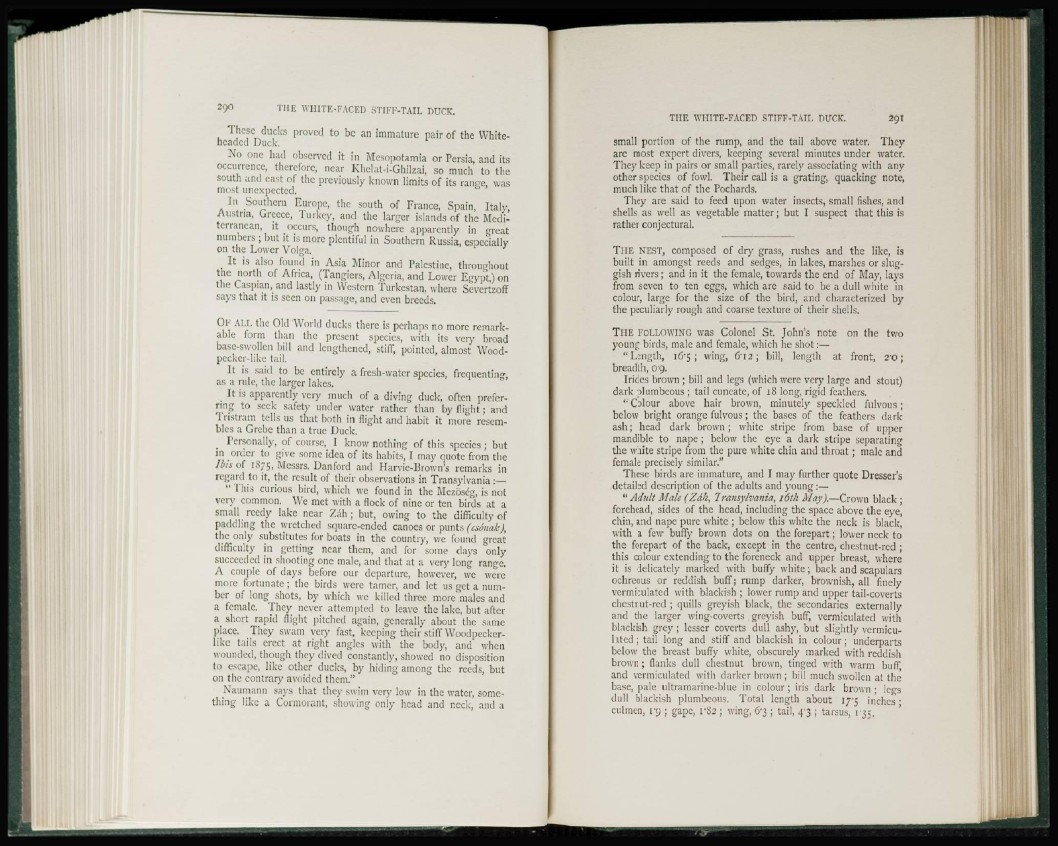
These ducks proved to be an immature pair of the Whiteheaded
Duck.
No one had observed it in Mesopotamia or Persia, and its
occurrence, therefore, near Khelat-t-Ghilzai, so much to the
south and cast of the previously known limits of its range, was
most unexpected.
In Southern Europe, the south of France, Spain, Italy,
Austria, Greece, Turkey, and the larger islands of the Mediterranean,
it occurs, though nowhere apparently in great
numbers ; but it is more plentiful in Southern Russia, especially
on the Lower Volga.
It is also found in Asia Minor and Palestine, throughout
the north of Africa, (Tangiers, Algeria, and Lower Egypt,) on
the Caspian, and lastly in VVestcrn Turkestan, where SevertzofT
says that it is seen on passage, and even breeds.
OF ALL the Old "World ducks there is perhaps no more remarkable
form than the present species, with its very broad
base-swollen bill and lengthened, stiff, pointed, almost Woodpecker
like tail.
It is said to be entirely a fresh-water species, frequenting,
as a ride, the larger lakes.
It is apparently very much of a diving duck, often preferring
to seek safety under water rather than by flight; and
Tristram tells us that both in flight and habit it more resembles
a Grebe than a true Duck.
Personally, of course, I know* nothing of this species ; but
in order to give some idea of its habits, I may quote from the
Ibis of 1875, Messrs. Dan ford and Harvie-Brown's remarks in
regard to it, the result of their observations in Transylvania :—
" This curious bird, which we found in the Mczoseg, is not
very common. We met with a flock of nine or ten birds at a
small reedy lake near Zah ; but, owing to the difficulty of
paddling the wretched square-ended canoes or punts (csfaak),
the only substitutes for boats in the country, we found great
difficulty in getting near them, and for some days only
succeeded in shooting one male, and that at a very long range.
A couple of days before our departure, howrcver, we were
more fortunate ; the birds were tamer, and let us get a number
of long shots, by which we killed three more males and
a female. They never attempted to leave the lake, but after
a short rapid flight pitched again, generally about the same
place. They swam very fast, keeping their stiff Woodpeckerlike
tails erect at right angles with the body, and when
wounded, though they dived constantly, showed no disposition
to escape, like other ducks, by hiding among the reeds, but
on the contrary avoided them."
Kallmann says that they swim very low in the water, something
like a Cormorant, showing only head and neck, and a
small portion of the rump, and the tail above water. They
are most expert divers, keeping several minutes under water.
They keep in pairs or small parties, rarely associating with any
other species of fowl. Their call is a grating, quacking note,
much like that of the Pochards.
They are said to feed upon water insects, small fishes, and
shells, as well as vegetable matter; but I suspect that this is
rather conjectural.
THE NEST, composed of dry grass, rushes and the like, is
built in amongst reeds and sedges, in lakes, marshes or sluggish
rivers; and in it the female, towards the end of May, lays
from seven to ten eggs, which are said to be a dull white in
colour, large for the size of the bird, and characterized by
the peculiarly rough and coarse texture of their shells.
THE FOLLOWING was Colonel St. John's note on the two
young birds, male and female, which he shot:—
"Length, 16'$ ; wing, 612 ; bill, length at front, 2'0 ;
breadth, 09.
Irides brown ; bill and legs (which were very large and stout)
dark plumbeous ; tail cuneatc, of 18 long, rigid feathers.
Colour above hair brown, minutely speckled fulvous ;
below bright orange fulvous ; the bases of the feathers dark
ash; head dark brown; white stripe from base of upper
mandible to nape ; below the eye a dark stripe separating
the white stripe from the pure white chin and throat; male and
female precisely similar."
These birds are immature, and I may further quote Dresser's
detailed description of the adults and young :—
" Adult Male (Zdh, Transylvania, ihl/i May),—Crown black ;
forehead, sides of the head, including the space above the eye,
chin, and nape pure white ; below this white the neck is black,
with a few buffy brown dots on the forepart; lower neck to
the forepart of the back, except in the centre, chestnut-red ;
this colour extending to the forcneck and upper breast, where
it is delicately marked with buffy white ; back and scapulars
ochreous or reddish buff; rump darker, brownish, all finely
vermiculated with blackish ; lower rump and upper tail-coverts
chestnut-red ; quills greyish black, the secondaries externally
and the larger wing-coverts greyish buff, vermiculated with
blackish grey ; lesser coverts dull ashy, but slightly vermiculated
; tail long and stiff and blackish in colour ; underparts
below the breast buffy white, obscurely marked with reddish
brown ; flanks dull chestnut brown, tinged with warm buff,
and vermiculated with darker brown ; bill much swollen at the
base, pale ultramarine-blue in colour ; iris dark brown ; legs
dull blackish plumbeous. Total length about 17-5 inches *
culmen, i-g ; gape, 1*82 ; wing, 6"3 ; tail, 43 ; tarsus, 1-35.